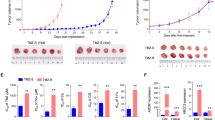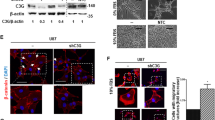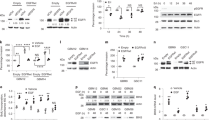Abstract
The early growth response gene-1 (Egr-1) is a tumor suppressor which plays an important role in cell growth, differentiation and apoptosis. Egr-1 has been shown to be down-regulated in many types of tumor tissues. Trifluoperazine (TFP), a phenothiazine class of antipsychotics, restored serum-induced Egr-1 expression in several cancer cell lines. We investigated the effect of Egr-1 expression on the TFP-induced inhibition of cell growth. Ectopic expression of Egr-1 enhanced the TFP-induced antiproliferative activity and downregulated cyclin D1 level in U87MG glioma cells. Our results suggest that antipsychotics TFP exhibits antiproliferative activity through up-regulation of Egr-1.
Similar content being viewed by others
Article PDF
Author information
Authors and Affiliations
Rights and permissions
This is an Open Access article distributed under the terms of the Creative Commons Attribution Non-Commercial License (http://creativecommons.org/licenses/by-nc/3.0/) which permits unrestricted non-commercial use, distribution, and reproduction in any medium, provided the original work is properly cited.
About this article
Cite this article
Shin, S., Kim, C., Hong, D. et al. Implication of Egr-1 in trifluoperazine-induced growth inhibition in human U87MG glioma cells. Exp Mol Med 36, 380–386 (2004). https://doi.org/10.1038/emm.2004.50
Published:
Issue date:
DOI: https://doi.org/10.1038/emm.2004.50
Keywords
This article is cited by
-
The antipsychotic agent trifluoperazine hydrochloride suppresses triple-negative breast cancer tumor growth and brain metastasis by inducing G0/G1 arrest and apoptosis
Cell Death & Disease (2018)
-
cAMP regulates vegetative growth and cell cycle in Candida albicans
Molecular and Cellular Biochemistry (2007)



